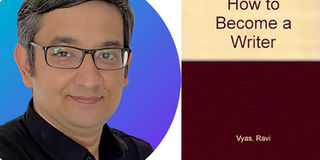
How To Become A Writer by Ravi Vyas is a timeless book filled with time-honoured guides on how to master the craft of writing.
The author unabashedly says, right out of the gate, that the purpose of this book is to help those interested in making a living through writing.
So this book is not about the art of creative writing, which is primarily intended for self-expression.
Rather, it seeks to equip the reader with commercial writing skills that come in handy when writing film-scripts, advertisements for TV, radio, textbooks, among others.
This separates the art of writing from the craft of writing. The latter ensures you write well, while the former is focused on making you live well.
Nonetheless, the advice of creative writers is included in order to bolster one’s understanding of certain disruptive principles that cut a swathe through whole spectrum of the written word.
When the American writer Ernest Hemingway, for instance, was asked about the essential qualifications of a writer, he replied with characteristic bluntness: “…a built-in, shock-proof s—t detector.”
Ten Commandments
It begins with A Writer’s Ten Commandments, enunciated by Stephen Vizinczey, a Hungarian writer who started to learn English at the age of 24.
One of these Commandments is “Thou Shalt Not Drink, Smoke or Take Drugs.” For these tend to create a confusion of mind that is ill-suited to a clarity of expression.
However, it is true that five of the first six American Nobel Prize winners for Literature—Lewis, O’Neill, Faulkner, Hemingway, and Steinbeck—were alcoholics, but these were creative writers.
Beyond this literary Decalogue, as it were, the author advises that every writer take into consideration the reader’s level of competence.
Reading as a skill
Reading, it is noted, is a skill that will die if not practiced.
“That is why many people who have once learned to read and write, later in their lives become functional illiterates because they have not kept with their reading.”
This is why one’s commercial writing must be as simple as possible. Since people, especially Ugandans, who due to a poor reading culture are largely functionally illiterate.
Reader’s motivation
The level of a reader’s motivation is examined.
Insightfully, we are reminded that people read to forget (that is, as a way to forget, such as reading a light novel to relax or be diverted from the pressures of life) and they read to learn.
In both cases, though, a writer must recall The Principle of Least Effort.
“This says that persons will expend the least amount of effort to reach a given goal. Of course no writer can possibly know which path will require the least effort but there is a law which states that the level of difficulty of a task that a learner will attempt varies with the level of motivation.”
Technical Tips
Writers must always change the negative into affirmative statements where possible. For instance, “The Man who designed the bridge is not alive” into “The Man who designed the bridge is dead.”
When it comes to sentences, prefer the interrogative to declarative forms: “Is this the malt…Jack built” should be changed to “This is the malt…Jack built.”
Again, the passive should be converted to the active form: “This is the malt…was contained in the house that Jack built” becomes “This is the malt…lay in the house that Jack built.”
Writing that sells
Commercial writing sells not because it intends to do so but because it fulfills a demand.
Here, we may look at textbooks.
They are written with the purpose of bridging the gap between knowledge and ignorance in our education system.
Such writing has no place for self-expression and is geared strictly towards comprehension and learning.
Author: Ravi Vyas
Title: How to Become a Writer
Availability: Amazon
Cost: Shs78,000
Published: 1993
Pages: 120






